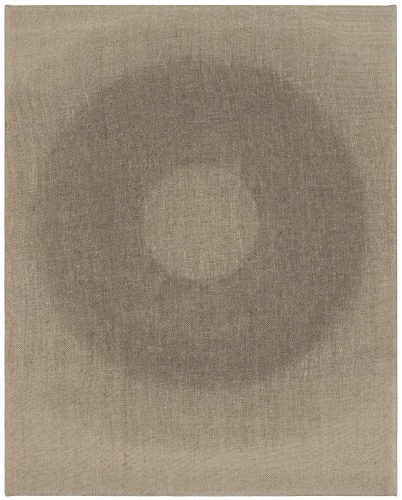
Ferner G, 2012, vegetable oil on canvas, 19 5/8 x 15 3/4".
Helmut Federle
By David Frankel
February 1, 2014
Once again working in series, as he did for his last show at this gallery, in 2009-10, the Swiss artist Helmut Federle has produced a still more refined and concentrated group of paintings than he did then. As in those earlier works, whose overlapping planes admit a pentagonal shape toward the center of each picture, Federle is working with a single geometric form, this time a circle. But he has eliminated almost all color, in fact has largely eliminated paint: The medium of most of the new works is no more than darken in the areas stained with oil. The phrase "no more than," though, falls short of justice, for it doesn't reflect the subtlety of the ways and degrees of darkening that distinguish the works' circles from their surround. Nor is this summary of Federle's method predictive of the paintings' cumulative effect, both when seen one by one and when looked at together, in their particular installation in this show.
Actually, the phrase "summary of Federle's method" itself needs revision, for just what that method might have been is not self-evident. I assume that it involved a brush, but there's little trace of brushwork in the paintings: The rings of oil have sunk into the absorbent fabric of the unprimed canvas, which looks less as if medium had been applied to it than as if a part of its color and texture had somehow clouded and condensed. As in the earlier exhibition, most of the works here were extracted from a larger series; the show's elegant book reproduces others, and one or two of these suggest signs of the hand in the form of faint bars where a brushstroke might have begun or ended. In the works chosen for New York, though, the circle appears almost as an emanation from within the canvas, or an emanation of the canvas. And while all the pictures are the same size -- an even European 50 x 40 centimeters, or 19 3/8 x 15 3/4 inches -- the images vary. In Ferner Q, 2013, for example, the circle is light but distinct and contains an inner aureole around a center of unstained canvas, while in Ferner G, 2012, it is both broader and darker, and its center and an area around it mediate between its shade and that of the canvas beyond. How Federle managed these shifting shades is enigmatic: Perhaps he used just thinner and thicker treatments of vegetable oil, but the softness of some of the edges -- and the variance of soft and hard edges is again fairly mysterious -- suggests a more osmotic process, as though the spread of the oil through the fabric were some combination of the artist's intention and the independent behaviors of those two materials.
Everyone will have their own examples of the circle in art and art history, and the images that come to them will no doubt color their response to these works. I myself think of Vasari's story of the perfect circle that Giotto drew freehand to demonstrate his skill to Pope Benedict XI, but also of a different iconographic tradition, not circular: that of the veronica, the vera icon, or "true image," said to be the face of Christ left on a cloth that Saint Veronica laid over him in compassion at Calvary. The idea of an image not produced on the cloth but generated within it by some transformation of its substance for me recalls Federle's series, and the veronica also relates to the experience the works produce, which has an intensity that might be called spiritual. In part, this feeling may arrive through the placement of each circle a little nearer the top of the canvas than the bottom, as if in ascension. The work's asceticism also contributes, as did the installation: a row of paintings along each side wall, channeling us toward a third wall holding a single painting hung higher than the rest -- the only painting here to include actual paint, and the image a circle intersected by a cross. The echo of a church's nave and altar was unmistakable, but I hesitate at a Christian reading of these works: The problem Federle seems to be addressing is a more general one of translating a spiritual feeling into formal terms.
DAVID FRANKEL